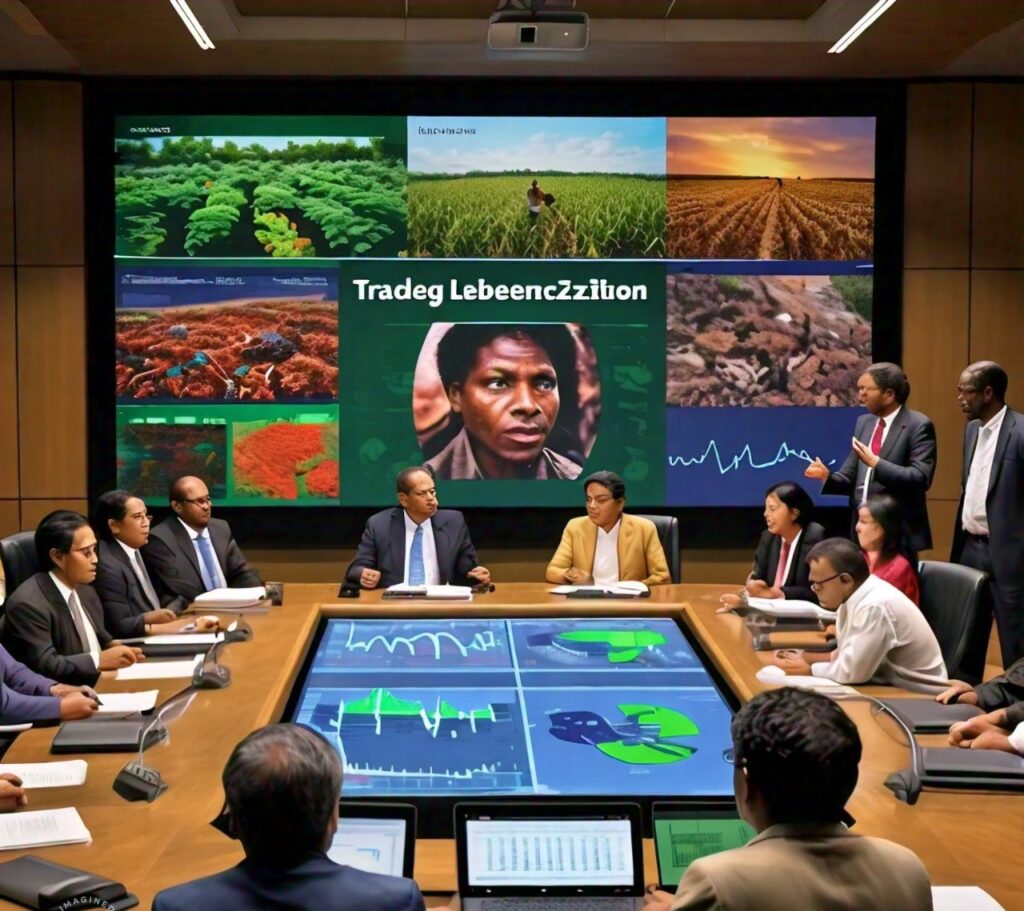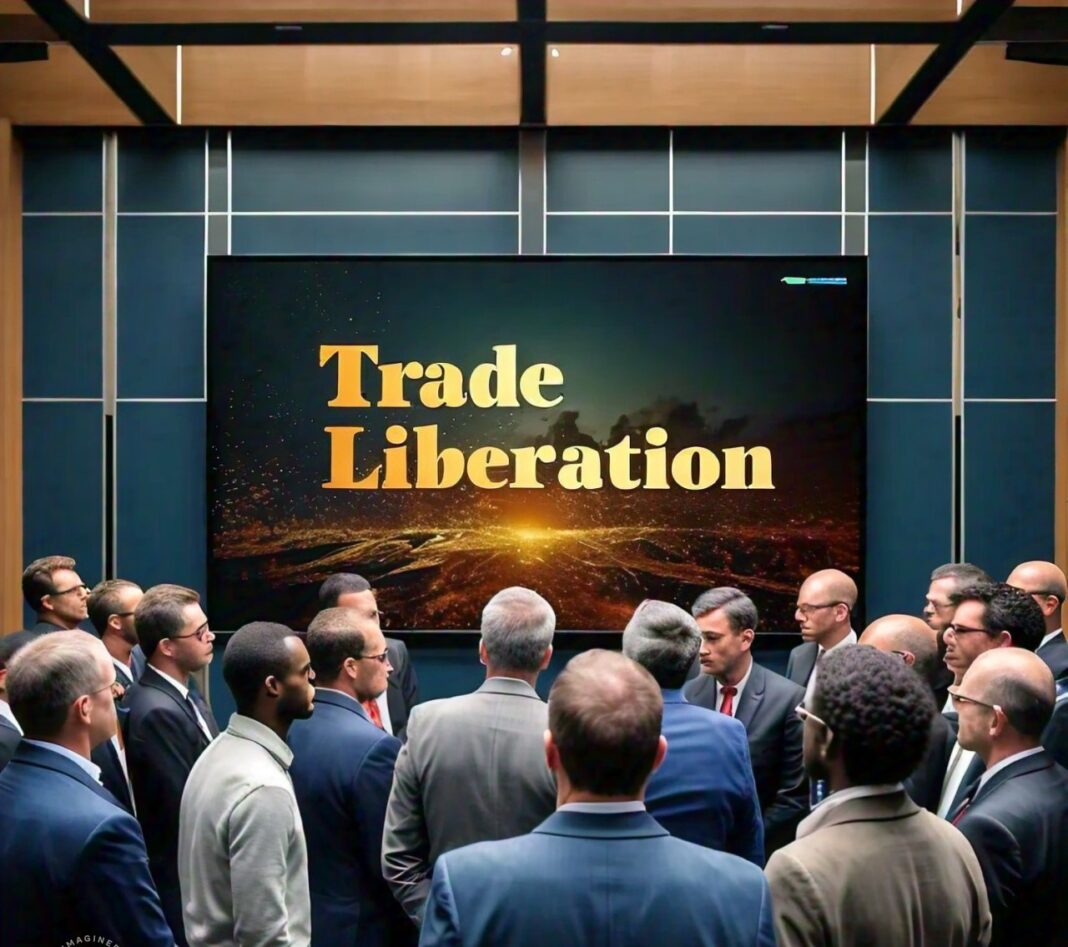Trade liberalization, the process of reducing or eliminating trade barriers such as tariffs, quotas, and import restrictions, is widely regarded as a catalyst for economic growth. For economists and analysts, understanding how these policy shifts affect different regions and countries is essential in evaluating the broader implications on global and local economies. This section delves into the complex relationship between trade liberalization and economic growth, focusing on its potential to either spur development or exacerbate existing economic vulnerabilities.
In recent years, several studies have highlighted the dual nature of trade liberalization. On one hand, it can lead to increased GDP, productivity gains, and enhanced economic expansion by opening markets, fostering competition, and enabling access to a wider range of goods and services. Countries like Mexico and various developing nations have demonstrated significant economic benefits from embracing more open trade policies. For instance, trade liberalization in these regions has been linked to higher growth rates and improved economic resilience(Brookings).
However, the impact of trade liberalization is not universally positive. In some cases, rapid opening of markets without adequate support structures can lead to economic instability, job losses in vulnerable industries, and increased income inequality. This nuanced perspective is critical for economists and analysts who must assess both the opportunities and risks associated with trade liberalization. For example, while some regions have experienced growth, others have struggled with financial crises exacerbated by swift liberalization policies
As we explore the various dimensions of trade liberalization’s impact on economic growth, it is crucial to consider these multifaceted outcomes. The following sections will provide a deeper analysis of how trade liberalization influences different aspects of economic performance, with a particular focus on GDP growth, productivity improvements, and the overall expansion of economies.
Theoretical Framework
Economic Theories Supporting Trade Liberalization
Trade liberalization is often supported by a range of economic theories that argue for its positive impact on economic growth. These theories provide the foundation for understanding how reducing trade barriers can enhance a country’s economic performance.
- Comparative Advantage
One of the most fundamental theories supporting trade liberalization is the concept of comparative advantage, introduced by David Ricardo in the early 19th century. This theory posits that countries should specialize in the production of goods and services where they have a relative efficiency advantage and trade for those where they are less efficient. By doing so, all participating nations can benefit from increased output and consumption, leading to overall economic growth. This specialization allows countries to produce at lower opportunity costs, thus maximizing global production and efficiency. - Heckscher-Ohlin Model
The Heckscher-Ohlin model expands on the concept of comparative advantage by focusing on a country’s factor endowments, such as labor, land, and capital. According to this model, countries will export goods that use their abundant factors intensively and import goods that require factors in which they are relatively scarce. Trade liberalization facilitates this exchange by reducing barriers, thereby allowing countries to capitalize on their resource endowments and enhance their economic growth through more efficient production and allocation of resources. - New Trade Theories
In contrast to classical theories, new trade theories recognize the role of economies of scale and network effects in modern global trade. These theories suggest that trade liberalization can lead to increased market size, enabling firms to achieve economies of scale, reduce costs, and increase competitiveness. Additionally, exposure to international markets fosters innovation, as firms are incentivized to improve products and processes to maintain a competitive edge. This dynamic can drive productivity improvements and contribute significantly to economic growth.
Further Read: The Role of Business Investment in Economic Forecasting

Counterarguments and Critiques
While the economic theories supporting trade liberalization highlight its potential benefits, there are also notable critiques and counterarguments that emphasize the risks and challenges associated with opening up markets.
- Protectionist Views
Protectionist arguments contend that trade liberalization can harm domestic industries, particularly those that are not competitive on a global scale. By removing tariffs and other trade barriers, local businesses may struggle to compete with foreign firms that benefit from lower production costs. This can lead to job losses, business closures, and a decline in certain sectors, which can negatively impact overall economic growth, particularly in regions heavily reliant on protected industries. - Potential Downsides
Critics also point to the potential for trade liberalization to exacerbate income inequality both within and between countries. The benefits of trade are not always evenly distributed, with wealthier nations and regions often gaining more than poorer ones. Additionally, industries that are exposed to international competition may experience wage stagnation or decline, further widening the gap between skilled and unskilled workers. In some cases, the rapid opening of markets can lead to economic instability, as seen in financial crises that have followed aggressive liberalization policies in certain developing nations.
Impact on GDP and National Income
Empirical Evidence on GDP Growth
The relationship between trade liberalization and GDP growth has been a central focus for economists, with numerous empirical studies providing evidence of its positive impact. Countries that have embraced trade liberalization often experience significant increases in GDP, driven by expanded market access, increased foreign investment, and enhanced efficiency.
Case Studies of Successful Trade Liberalization
- China: China’s economic transformation since the late 20th century is a prime example of how trade liberalization can drive GDP growth. After joining the World Trade Organization (WTO) in 2001, China reduced trade barriers and opened its markets to global competition. This shift led to a surge in exports, a significant influx of foreign direct investment, and rapid industrialization, propelling China to become the world’s second-largest economy (World Bank).
- India: Similarly, India’s trade liberalization efforts in the early 1990s, characterized by the reduction of tariffs and trade restrictions, have been credited with fostering robust economic growth. The liberalization policies led to increased trade flows, technological advancements, and integration into the global economy, which collectively contributed to a higher GDP growth rate(World Bank).
Comparative Analysis of GDP Growth Rates Pre- and Post-Liberalization
- Mexico: In Mexico, trade liberalization policies, particularly the signing of the North American Free Trade Agreement (NAFTA) in 1994, have had a profound impact on the country’s GDP growth. The agreement opened up new markets for Mexican products, particularly in the manufacturing sector, leading to increased production and economic growth. A comparative analysis of Mexico’s GDP growth rates before and after liberalization shows a clear acceleration in economic expansion post-liberalization(Site homepage).
- Vietnam: Vietnam’s gradual trade liberalization, starting in the late 1980s and culminating in its accession to the WTO in 2007, has similarly led to sustained GDP growth. The country’s economic reforms, which included the reduction of trade barriers and encouragement of foreign investment, have transformed Vietnam into one of the fastest-growing economies in Southeast Asia(Site homepage).
Sectoral Contributions to GDP
Trade liberalization’s impact on GDP is often uneven across different sectors of the economy, with some industries benefiting more than others.
- Manufacturing and Industrial Sectors
- In many countries, the manufacturing sector is a significant beneficiary of trade liberalization. The removal of tariffs and other barriers allows manufacturers to access larger markets, source cheaper inputs, and benefit from economies of scale. For instance, the automotive and electronics industries in countries like Mexico and China have seen substantial growth due to increased exports facilitated by trade liberalization(Brookings).
- Agricultural Sector
- The agricultural sector’s response to trade liberalization can be more mixed. While some countries benefit from increased access to international markets for their agricultural products, others may struggle with competition from subsidized imports. For example, while trade liberalization has opened new markets for Brazilian agricultural exports, farmers in smaller economies have sometimes been adversely affected by the influx of cheaper foreign goods(World Bank).
- Service Sector
- The service sector, particularly in developed economies, also experiences significant growth due to trade liberalization. Services such as finance, insurance, and information technology often see increased demand as businesses expand their operations globally. For example, India’s IT service industry has thrived due to the country’s trade liberalization policies, which have allowed Indian firms to become global leaders in outsourcing and software development(Brookings).
You can also Read: What is a Chartered Financial Analyst

Productivity Improvements and Economic Expansion
Mechanisms of Productivity Growth through Trade Liberalization
Trade liberalization can lead to significant productivity improvements across economies by fostering competitive markets, encouraging innovation, and enabling access to advanced technologies. Economists and analysts often explore these mechanisms to understand how trade policies can enhance economic efficiency and overall growth.
- Increased Competition and Efficiency
One of the primary ways trade liberalization boosts productivity is by increasing competition. When markets open up to international players, domestic firms are pushed to innovate, reduce costs, and improve product quality to remain competitive. This competitive pressure often leads to higher efficiency levels and better resource allocation within industries. For example, following trade liberalization in India, many local industries underwent significant restructuring, leading to increased productivity and more efficient production processes(Site homepage). - Technology Transfer and Innovation
Trade liberalization facilitates the flow of technology across borders, enabling firms in developing countries to access cutting-edge tools and processes. This transfer of technology can lead to substantial productivity gains, especially in sectors like manufacturing and services. For instance, China’s integration into the global economy has been accompanied by significant technology transfer, which has been instrumental in the rapid modernization of its industries(World Bank). Additionally, exposure to global markets drives innovation, as firms seek to differentiate themselves and capture larger market shares. - Economies of Scale
By expanding market access, trade liberalization allows firms to achieve economies of scale, reducing per-unit costs and increasing production efficiency. This is particularly evident in industries such as electronics, automotive, and textiles, where large-scale production is crucial for competitiveness. The ability to produce at scale not only lowers costs but also enables firms to reinvest in research and development, further enhancing productivity and economic expansion(Brookings,World Bank).
Policy Recommendations for Effective Trade Liberalization
Developing a Comprehensive Trade Strategy
For trade liberalization to effectively contribute to economic growth and development, it is crucial to develop a well-thought-out trade strategy that aligns with the country’s economic goals and capacities. Economists and analysts recommend several key elements that should be incorporated into such a strategy:
- Assessing Domestic Industry Strengths and Weaknesses
Before embarking on trade liberalization, policymakers should conduct a thorough assessment of the domestic industries. Understanding which sectors are competitive globally and which are vulnerable is critical for crafting policies that maximize benefits and minimize risks. For example, a country with a strong agricultural sector might focus on negotiating trade deals that open up markets for its agricultural exports, while protecting nascent industries that are not yet ready to face global competition(Brookings). - Promoting Diversification
Economies that are overly reliant on a narrow range of exports are particularly vulnerable to global market fluctuations. Trade liberalization should be accompanied by policies that encourage diversification of the economy. This includes investing in new industries, fostering innovation, and supporting small and medium-sized enterprises (SMEs) to reduce dependence on a limited set of exports(Site homepage,World Bank). - Building Institutional Capacity
Strong institutions are essential for managing the complexities of trade liberalization. This includes transparent regulatory frameworks, efficient customs procedures, and robust legal systems to enforce contracts and resolve disputes. Building institutional capacity ensures that the benefits of trade liberalization are fully realized and that the economy can adapt to changes in the global market(Brookings).
Mitigating Negative Impacts
While trade liberalization offers significant benefits, it can also have negative consequences, particularly for vulnerable industries and populations. Effective policies must be in place to mitigate these impacts:
Social Safety Nets
Trade liberalization can lead to job losses in industries that are unable to compete with foreign imports. To mitigate the social impact, governments should implement social safety nets, such as unemployment benefits, retraining programs, and support for displaced workers. These measures help ensure that the workforce can transition smoothly to new opportunities created by trade(Site homepage).
Addressing Income Inequality
Trade liberalization can exacerbate income inequality, particularly if the benefits are unevenly distributed. Policymakers should consider tax policies and redistributive measures to ensure that the gains from trade are shared broadly across society. This might include progressive taxation, targeted social programs, and investments in education and healthcare(World Bank).
Environmental and Labor Standards
Trade liberalization can sometimes lead to a “race to the bottom” in environmental and labor standards, as countries compete to attract foreign investment. To prevent this, trade agreements should include provisions that enforce minimum standards for environmental protection and workers’ rights. This ensures that economic growth does not come at the expense of the environment or the welfare of the labor force(Brookings,Site homepage).
Engaging in Multilateral and Bilateral Trade Agreements
Trade agreements, both multilateral and bilateral, are critical tools for managing trade liberalization. Policymakers should carefully consider the following aspects when negotiating and implementing these agreements:
- Balancing National Interests and Global Obligations
When entering into trade agreements, countries must balance their national interests with their obligations under international trade rules. This involves negotiating terms that provide market access for key industries while protecting sensitive sectors. For instance, countries with strong manufacturing bases might prioritize agreements that reduce tariffs on industrial goods while maintaining protections for agriculture(World Bank). - Ensuring Fair and Reciprocal Trade
Trade agreements should be based on the principle of reciprocity, ensuring that all parties benefit equally. This requires careful negotiation to avoid imbalances where one country gains disproportionately at the expense of others. Policymakers should also be vigilant in enforcing trade agreements to prevent unfair practices such as dumping or intellectual property theft(Site homepage,World Bank). - Adapting to Changing Global Trade Dynamics
The global trade environment is constantly evolving, with new challenges such as digital trade, climate change, and geopolitical tensions. Policymakers must stay informed about these changes and be prepared to adapt their trade strategies accordingly. This might involve renegotiating existing trade agreements, forming new alliances, or implementing domestic reforms to stay competitive in the global market(Brookings).
Further Read: The Role of Currency Exchange Rates in Economic Forecasting

Policy Implications and Recommendations
Guiding Principles for Policymakers
- Structuring Trade Liberalization Policies to Maximize Economic GrowthTo effectively structure trade liberalization policies that enhance economic growth, policymakers should consider several key principles:
- Incremental Implementation: Gradual reduction of trade barriers allows businesses and workers time to adapt. Sudden liberalization can lead to short-term disruptions and economic instability.
- Sectoral Flexibility: Tailoring trade policies to different sectors can address specific challenges and opportunities. For example, protecting nascent industries while encouraging competition in mature sectors can balance growth and stability.
- International Collaboration: Engaging in multilateral trade agreements and partnerships can expand market access and foster cooperation on global economic issues. Bilateral and regional agreements should complement broader international efforts.
- Economic Diversification: Trade liberalization should be accompanied by strategies to diversify the economy. Relying too heavily on specific industries or markets can expose economies to risks, so fostering a range of sectors can enhance resilience.
- Regulatory Quality: Ensuring that regulatory frameworks are transparent, efficient, and supportive of business innovation is crucial. Reducing bureaucratic red tape and fostering a competitive business environment can amplify the benefits of trade liberalization.
- Importance of Supporting Policies
- Education: Investing in education equips the workforce with skills necessary to thrive in a liberalized economy. Education programs should focus on both technical skills and soft skills to enhance adaptability and innovation.
- Infrastructure: Developing robust infrastructure, including transportation, communication networks, and energy, supports efficient trade and economic activities. Infrastructure improvements reduce transaction costs and facilitate smoother trade flows.
- Social Safety Nets: Implementing social safety nets helps mitigate the negative impacts of trade liberalization on vulnerable populations. Programs such as unemployment benefits, retraining initiatives, and income support can provide stability and ensure a more equitable
Also Read: Why Retail Sales Figures Are a Leading Economic Indicator
Conclusion
Trade liberalization, when implemented thoughtfully and supported by comprehensive policies, has the potential to drive significant economic growth. Policymakers must focus on gradual and sector-specific approaches, collaborate internationally, and invest in education, infrastructure, and social safety nets to maximize benefits and ensure equitable outcomes. Future research should address the long-term, sectoral, regional, social, and environmental impacts of trade liberalization, utilizing robust data and advanced modeling techniques. By integrating these insights into policy development, governments can better harness the advantages of trade liberalization and promote sustained economic prosperity.






